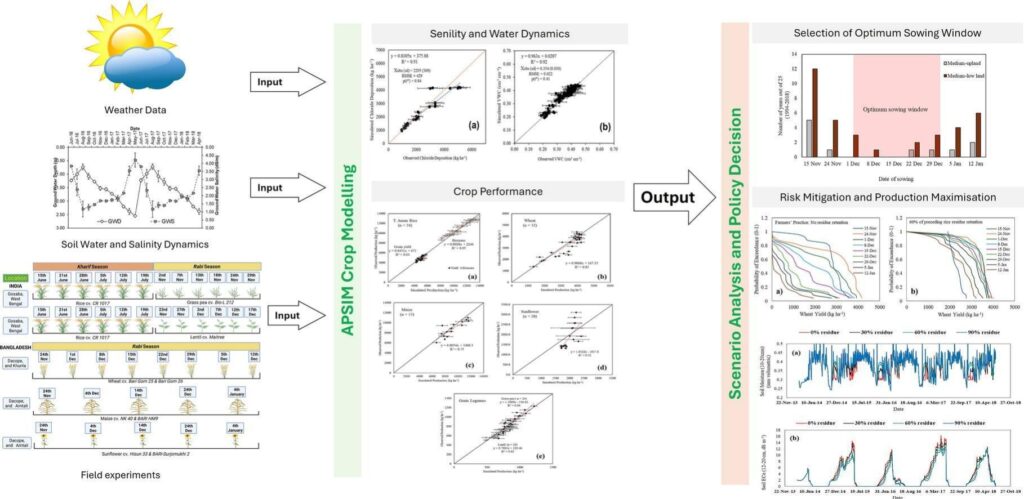Achieving the once-unthinkable: Successful Rabi cropping via technology integration in coastal saline Bengal
Donald S. Gaydon a, Sukamal Sarkar ab, Mohammed Mainuddin c, Edward G. Barrett-Lennard d, Richard W. Bell d, Koushik Brahmachari e, Md. Maniruzzaman f, Buddheswar Maji g, Md. Alimur Rahman h, Md. Enamul Kabir i, Md.Harunor. Rashid h, Md. Shahidul Islam Khan h, Mustafa Kamal Shahadat h, Khokan Kumer Sarker h, Mark R. Glover j, Sukanta Kumar Sarangi k, Apurbo Kumar Chaki h, Dhiman Burman g, Md. Belal Hossain f, Uttam Kumar Mandal g…Manoj Kumar Nanda l
Abstract
Context
Agricultural productivity in the coastal saline zones of the Ganges Delta in Bangladesh and West Bengal, India faces significant constraints due to high soil salinity, seasonal waterlogging, freshwater scarcity, and increasing climatic variability. These challenges collectively limit the sustainability and intensification of dry season (Rabi) cropping systems, thereby impeding regional food security and livelihoods.
Objective
This study aimed to assess the key biophysical constraints affecting Rabi season cropping systems and to evaluate the integration of key agronomic and water management technologies using a combination of field experimentation and cropping systems modelling, with the goal of supporting climate-resilient intensification in coastal saline environments.
Method
Two years of field experimentation were conducted across multiple locations, generating a comprehensive validation dataset comprising 139 crop instances, including transplanted Aman (T. Aman) rice, wheat, maize, sunflower, grass pea, and lentil. These datasets represented a diverse range of potentially integratable technologies and agroecological conditions. The Agricultural Production Systems Simulator (APSIM), employing the APSIM-SWIM3 module, was used to simulate crop production outcomes for a range of different integrated technologies. To achieve this, a novel modelling approach was developed to dynamically simulate surface soil salinity and moisture, and then its subsequent effects on crop production, using daily inputs of water table depth, salinity, irrigation, and climatic data.
Results and conclusions
APSIM simulations closely matched observed field data, with performance metrics (RMSE, R2) falling within acceptable ranges of experimental uncertainty. Long-term (25-years) scenario analyses demonstrated that advancing sowing dates by 15–30 days could substantially increase yield potential by reducing salinity exposure during critical crop stages. However, early sowing increased the risk of waterlogging, especially in low-lying fields. In some cases, the incorporation of in-field drainage structures was shown to mitigate waterlogging risks effectively. In situations where this is not possible due to landscape constraints, model-based identification of optimal sowing periods provided a viable alternative to reduce risk of waterlogging. Additionally, the retention of crop residues was shown to reduce surface soil evaporation and salinity accumulation, increasing yield, particularly in late-sown Rabi crops.
Significance
Focusing on the integration of four key technologies— short-season improved Kharif rice varieties, early Rabi crop sowing, field drainage, and crop residue retention—this study delivers a validated, model-supported decision framework for enhancing Rabi cropping in coastal agroecosystems. The results offer a scalable foundation for site-specific agronomic planning, community-based water management, and policy formulation aimed at climate-resilient cropping system intensification in the vulnerable coastal saline regions of South Asia.

